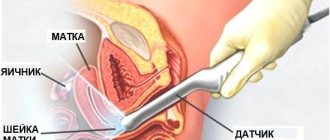Main causes of discharge
Discharge after medical termination of pregnancy is normal. The woman’s body cleanses the uterine cavity from fragments of the fertilized egg, accompanying the process with moderately heavy bleeding.
The causes of discharge are due to the following factors:
- detachment of the fertilized egg;
- intense contraction of the cervix;
- rupture of the vessels of the uterine cavity.
During an abortion, the mucous structures of the walls of the uterus, the outer layer and the endometrium are damaged. Bleeding can provoke sudden changes in a woman’s hormonal levels.
Discharge after medical abortion: features, types, pathology and norm
Discharge after medical abortion is an indicator of successful completion of the procedure. Medical abortion is the termination of an unwanted pregnancy using abortifacient pharmaceutical drugs. The action of the active components of medications is aimed at stimulating the muscular muscles of the uterine body and expelling the fertilized egg. Under the influence of the drug, early miscarriage occurs.
An abortion is performed at 6-7 weeks of pregnancy, when the fertilized egg has not yet implanted into the walls of the uterine cavity. The method is considered low-traumatic. After the procedure, the risks of serious complications are reduced, and there is no negative impact on the functionality of the female reproductive system.
Before the procedure, a full diagnostic study is performed: possible contraindications are determined, and detailed therapeutic tactics are drawn up. After the procedure, women are given detailed recommendations about possible complications, the nature of the discharge, normal and pathological conditions in their general health.
Normal discharge
After an abortion, the risk of infection always increases. Prolonged and heavy bleeding can easily contribute to the development of this process. It is important to monitor your own health and control the nature of your discharge.
An abortion can be considered successfully completed if after the termination the following phenomena are absent:
- prolonged heavy brown discharge;
- yellow color of discharge;
- bad smell;
- atypical impurities in blood clots.
On the first day after taking the abortifacient drug, embryonic development stops. On the second day it is rejected. The process of expulsion of the fertilized egg is accompanied by cramping pain, pulling sensations in the lower abdomen, and discharge with clots of bright red and scarlet hue.
Normal excretion is not accompanied by an unpleasant odor, heavy or scanty bleeding, and does not contain curdled components.
Duration of discharge
The duration of post-abortion excretion depends entirely on the individual characteristics of the body, the timing of the medical abortion, and compliance with all doctor’s recommendations. Bleeding usually continues for several weeks.
Many women note the persistence of light spotting bleeding for 30-40 days after an abortion. Bleeding may occur before your next period. The next period occurs on the 50th day after a medical abortion. Women may bleed differently. For some, everything ends within 12 days after the procedure.
How soon does your period come after pharmaabortion?
The first day of the cycle will now be the day of the abortion. Those discharges that come after an abortion are also considered menstrual, even despite their large quantity and duration. However, the first “critical days” should come in 28–35 days, no later. The absence of menstruation is a clear sign of a malfunction. They are very different, but always require correct diagnosis and timely treatment.
The most common causes of this condition are:
- Hormonal imbalance in the body.
- Disorders caused by the inability of the endometrium to quickly recover.
The absence of menstruation for 35 days after an abortion is a reason to seek help from a gynecologist, otherwise it can lead to infertility.
It is possible that the absence of the menstrual cycle is caused by the further development of pregnancy. The likelihood of conception after an abortion is minimized, but fertilization occurs because women often ignore the need for contraception. Ideally, after pharmaabortion, you should maintain sexual rest for at least 30 days, since intimate relationships cause complications.
Nature of the discharge
Important criteria for assessing the normal completion of a pharmaceutical abortion are the color and volume of blood excretion. With heavy or scanty bleeding, the help of specialists is often required to preserve the functionality of the woman’s reproductive system, her health, even saving her life.
Discharge color
The mechanism of expulsion of the fertilized egg is determined by the type of drug chosen.
Normal discharge is characterized by the following features and stages of appearance:
- red or scarlet color (the first 1-6 days after taking the pills);
- brown spotting (following days after the cessation of scarlet discharge).
Brown discharge after an abortion can persist for 10-12 days. This is due to the continued drainage of clotted blood. The color of the discharge varies from dark to black. Long-term secretion of dark brown mucus may suggest the presence of polyps in the uterus or the development of endometriosis. The condition is almost always associated with severe nagging pain in the lower abdomen and long-lasting dark (even black) discharge.
Yellow discharge characterizes the onset of the inflammatory process of the internal genital organs. The causative agents are staphylococci, E. coli, chlamydia, streptococci, trichomoniasis. Yellow discharge is often accompanied by an unpleasant smell of rotting. If atypical discharge occurs, it is important to sample the discharge from the cervical canal for pathogenic media.
As the uterus recovers, the discharge resembles a light pink ichor. For doctors, such symptoms are a signal of successful recovery of the body.
Discharge with pus is a sign of a sexually transmitted disease, inflammation of the ovaries, fallopian tubes of a bacterial nature. As a rule, a woman was infected before the termination of an unwanted pregnancy. Later infection occurs as a result of non-compliance with hygiene standards, unprotected sexual intercourse against the background of bleeding.
Pink discharge with mucus without an unpleasant odor, itching or irritation is normal and does not require special treatment.
Discharge of a large volume of mucus with an unpleasant odor, foam and a green tint indicates a fungal or bacterial disease of the internal genital organs.
A curd-like white discharge is characteristic of thrush caused by the Candida fungus. The disease has characteristic symptoms: burning, severe itching, pain during urination and sexual intercourse.
Discharge volume
Heavy discharge after an abortion is normal. Usually, all fragments of the fertilized egg, the dead epithelial layer at the site of attachment, leave the uterine cavity in the first 5 days after termination of pregnancy. Spotting brown discharge is not abundant, reminiscent of the last days of the active phase of the menstrual cycle.
The severity of post-abortion bleeding is influenced by a number of factors:
- characteristics of the body (age, weight, blood clotting ability, degree of muscle contractions of the uterus);
- gestational age (from the day of conception to 7 weeks with medical abortion);
- gynecological and general clinical history;
- compliance with the technique of the procedure (dosage, phased administration of funds).
Immediately after rejection of the fertilized egg, the discharge is slightly more intense than during normal menstruation. My health does not suffer. After 5-10 days, the bleeding decreases, the discharge is spotting. Heavy bleeding is indicated by the use of more than 3-4 pads of maximum absorbency per day (classical, urological).
Medical abortion. Reviews
Total messages: 4187
03/18/2012, Katerina
Hello, girls. I read your reviews and decided to share my opinion about MA. I’m from Volgograd, I’m 26 years old, I had my first pregnancy, everything went well, and now we’ve been raising a handsome son for more than 5 years. We lived all these years without any special protection and now you are on the verge of a second pregnancy. I am shocked and happy at the same time. But as always in our lives there are difficulties, and everything always happens at the wrong moment. So I decided to take MA. I came to the clinic with the appropriate profile, they did an ultrasound (it showed 4-5 weeks), at the doctor’s appointment they examined me, took the necessary tests, explained everything, signed a bunch of papers. And so I take three tablets of Mifepristone (03/16) and wait, somewhere in the afternoon of 03/17 my stomach started to hurt, as if the first labor contractions were starting. But then everything quickly went away. 03/18 I took 2t. Misoprostol and as the doctor told me, in 1.5 - 2 hours the discharge will begin and the fertilized egg should come out (looks like a shrimp). To be honest, I never saw the fertilized egg, there were only clots, or maybe I missed it. In the trailer everything is the same it happened, after taking 2 tablets, after 15 minutes the lower abdomen began to hurt very much, the pain continued for 15-20 minutes. Then everything went away but there was no discharge. The doctor was on the phone all the time. After talking with him, 2 hours after I took the pills, I took more spasmalgon (it relieves spasms of the vaginal muscles and improves the outflow of secretions) After taking the 1st tablet, everything seemed to return to normal and the usual periods began only with admixtures of clots, but that’s how it should be. Then after 14 days (counting from the first day) see a doctor for examination and ultrasound. See how everything went. Everything cost me 5700 2 ultrasounds, 2 appointments with a gynecologist + medications. Before this procedure my knees were shaking and my morale was so-so, I honestly need to decide on this. The only thing that saved me was the fact that I have a son .For me this is a great tragedy, and those girls who have not given birth, no matter how old you are, should not even think about getting rid of the child in any way. It’s very difficult mentally: I cried and had constant conversations with my husband. The problem was that I am Rh negative, but my husband is positive, and there is an option that the child may have Rh positive, causing a Rh conflict. I didn’t have this with my first baby, but I don’t know with the second one, I think because the doctor told me that if I went back weeks later, I would have to do a Rh blockade. Now I don’t even know what to do on the Internet, I read that the blockade should be done at 4-5 weeks, but the doctor says later. And I don’t know what to do. We are in In the future we are going to give birth to another child, what if it affects his development, what if something happens. Tell me who has encountered this!? I wish you happiness and health.
03/18/2012, Irina
Katerina, a friend of mine has exactly the same situation, she applied for an abortion and after 1.5 years of pregnancy, she registered with her and turned to Evgenia Mikhailovna Nazimova to avoid Rhesus conflict throughout her pregnancy. She is an excellent doctor of the highest category. I highly recommend it! You can ask her any questions on her website and make an appointment. Good luck to you!
03/18/2012, doll
I drank myrolut 2 hours ago, my stomach aches a little like during menstruation, there is no pain at all, the bleeding (menstruation) has increased, a little more profusely than during normal menstruation. I went to the toilet and something about 3 cm fell out somewhere, it doesn’t really look like a clot, because it’s dense on the outside and shaped like an oval with a long tail, as I understood it was the fertilized egg. The color is burgundy red-black. After 10 hours, drink again 2 Myroluta tablets. I will write you later.
03/17/2012, doll
I’m 26 years old. I read all sorts of terrible things here, I didn’t sleep at night, I generally panicked after what I read. An ultrasound showed the period was 2.5-3 weeks. Yesterday I had an MA (March 16) at 12 am. I took 3 tablets of Mifepristone at the doctor’s office, sat for 15 minutes and went home. Nothing happened to me. Nothing hurt, the panic was over), no discharge was. Today 17.03 there are 2 hours left before taking Mirolut (drink the first 2 tablets after 36 hours). It’s 10 p.m. now, about an hour ago I started bleeding (my period) with small clots. I didn’t feel them at all, I accidentally went to the toilet and saw a pad. I’ll drink Mirolut soon... I’ll write about the rest later.
03/16/2012, Julia
So, I decided to write about my MA. I’m married, I have a daughter, 2 years old, and we don’t want a second one yet, but it worked out, without hesitation I went to MA, because... it is more gentle. On the first day they did an ultrasound, they said that the fertilized egg had not yet come out into the uterus. She came 2 days later, everything became visible, they signed an agreement, drank the first 3 tablets. and after reading reviews on the Internet, I expected the worst (vomiting, dizziness). But nothing happened, not even a tug in my stomach. On the third day at home, I took 2 more tablets. After that, discharge should have started. As the gynecologist said, within the first 6- for about ten hours, but none followed, only a slight tug in my stomach. I called the doctor, she told me to take 2 more tablets, I drank it, and after about 2-3 hours, discharge began. I must say, it was quite scanty and painless. I didn’t have any clots. I didn’t see it. The discharge lasted 10 days. The next menstruation began after the usual cycle (i.e., from the 1st day of taking the pill, you add your cycle and get the date of the next menstruation.) In general, I want to tell you that it’s not worth it in this regard focus on others, we are all different, some have terrible pain and vomiting all over MA, and for others everything is calm. But the only thing I can say for sure (having read more than one similar experience) is that the pain is a little stronger, as with normal menstruation .Remember that for the first month of p/e MA you need to carefully protect yourself, you can’t get pregnant for a year, visit a gynecologist, get a control. ultrasound, smears and treatment of the cervix (colposcopy). And don’t take it so seriously, in the early stages there’s not even an embryo there, the heart isn’t beating yet. Maybe because I’m good with honey. education, but for me it was not so painful emotionally. Don’t worry, but think first.
03/15/2012, Natalya 26
01/27/2012, Natalya 26 years old Hello, my husband and I have been together for 10 years, we have two daughters, one is 3 years old and the other is 2 years old. Yesterday evening I took a test, it showed 2 stripes in the morning I also did the same control result. I did an ultrasound, nothing was visible, they told me to come back in 5 days. Life history: 1 pregnancy - miscarriage, 2 births, 3 births, 4 births. First, they did a mini (vacuum) and took out an egg. but at the repeat ultrasound they said that there was still a fetus. I had to go to the hospital to have a regular abortion under anesthesia and, under the guidance of the ultrasound, they said because the uterus is loose and they take me to the day hospital only if a year has passed since the birth. In theory, I had to lie there for 4 days, but I On the 3rd I left, I was worried sooooo much. But here again there are 2 stripes and I think the roofing felts are m.a. make roofing felts right away on a regular one, suddenly lie down like with a mini and then you suffer both morally and physically, roofing felts immediately lie down fell asleep woke up and it seems like that’s it. So I don’t know what to do. Answer
Additional symptoms
Vaginal discharge of normal color and volume is an indicator of a successful medical abortion. The main symptom, in addition to discharge from the cervical canal, is moderate pain.
When the following signs are added, pathology often develops:
- unpleasant odor (mostly sour or putrid);
- irritation of the mucous membranes of the external and internal genital organs;
- severe burning, itching;
- redness of the genital organs, swelling;
- inflammation extending to the inner thighs;
- curdled white-red discharge;
- foamy yellow discharge (a sign of an infectious disease).
To manifest the disease, it is important to use all methods of differential diagnosis (instrumental, laboratory methods). Atypical discharge is almost always a signal of a disorder of various origins.
Infections and bacteria
The use of synthetic drugs for abortion puts a tremendous burden on the body, which causes a decrease in resistance to the negative effects of infections and bacteria. There is a violation of the vaginal mucosa, as a result, harmful microorganisms easily penetrate the genitals and begin to multiply there quickly. When the uterus is an open wound, it is most susceptible to the development of an infectious process.
Such a phenomenon will definitely manifest itself sooner or later.
If the secretion begins to smell unpleasant, changes its color to yellow, green or gray, and severe itching is felt in the labia area and inside the vagina, this is a clear sign of the development of bacterial vaginosis.
Vaginosis often appears as a result of medication or surgery.
What should you be wary of?
Medical abortion is performed only within the walls of a medical center under the supervision of specialists. This is necessary to prevent the first complications after an abortion: blood loss, lack of discharge, clouding of consciousness. Over the next few days, women need to monitor their own health condition and immediately consult a doctor if their health worsens.
No discharge
After any abortion in women, discharge is an indicator of a successful procedure. The absence of discharge from the cervical canal indicates stagnation of blood in the uterine cavity.
The main causes of blood retention are:
- malignant endometrial tumor;
- polyps, blood clots in the cervical lumen;
- spasm of the muscular structures of the cervix.
Blood retention in the uterus contributes to the development of the inflammatory process due to rotting of fragments of the fertilized egg and the remains of dead epithelium. Such conditions require immediate treatment and often lead to generalized sepsis, even death. One of the serious complications of a medical abortion without discharge is spasm of the uterine muscles and the development of hematometra. The disease is characterized by complete or partial disruption of blood outflow. Pathology is rarely detected in the early stages.
As the disease progresses, the symptoms increase:
- pain in the lower abdomen;
- menstrual irregularities:
- sudden cessation of discharge after abortion.
The main goal of therapy is to completely remove blood from the uterine cavity. In the presence of an inflammatory process, a course of antibacterial therapy is carried out.
Heavy bleeding
Intense bleeding is a complication of medical abortion when there is a direct threat to the woman’s life.
Excessive amounts of blood can occur for a number of reasons:
- simultaneous administration of a large dose of an abortifacient drug;
- incomplete abortion (preservation of fetal egg remnants in the uterine cavity);
- intense physical activity:
- hot bath, sauna, steam bath;
- visiting a solarium;
- frequent douching;
- traumatization;
- tamponing.
Unfortunately, complications can arise even if all medical recommendations are followed, which is due to the individual characteristics of the female body.
If heavy or absent discharge is accompanied by nausea, body temperature rises, episodes of vomiting, severe malaise, low blood pressure and unbearable pain occur, then these are direct signals for immediate treatment.
Author: Anna Levina, doctor specially for Mama66.ru
Painful sensations during medical abortion
Pain during a medical abortion occurs due to contraction of the uterus (its muscular layer).
Mifepristone (the drug taken at the first stage) has little effect on the tone of the uterus, so any pain usually does not occur while taking it.
The main contribution of Misoprostol (Cytotec, taken in the second stage) to the abortifacient effect of the medical abortion complex is the intense stimulation of uterine contractions (uterine contractions). Due to contractions, the fertilized egg is expelled from the uterine cavity. But this effect, of course, has the opposite effect - cramping pain.
Pain in the lower abdomen appears 0.5-4 hours after taking Misoprostol, and can be of very different intensity, from subjectively subtle to unbearable. The nature of the painful sensations can be: cramping, pulling, pressing. If the pain is sharp, cutting in nature, this may indicate the presence of an ectopic pregnancy and in this case you should urgently seek medical help. The intensity of pain is directly proportional to the duration of pregnancy and largely depends on the woman’s individual pain threshold.
The duration of pain ranges from several hours to a day, on average about 3-4 hours. A long duration of pain is usually associated with a relatively long pregnancy, since in this situation it is more difficult for the uterus to expel the fertilized egg.
After expulsion of the fertilized egg from the uterine cavity, the pain usually calms down.
Penney G. in 2006, during his study, asked patients who had undergone medical termination of pregnancy to rate their pain on a 10-point scale, where: “1” is mild pain, and “10” is unbearable pain. The obtained statistical data is given below:
- Moderate pain (3-5 points) – 25%;
- Very severe and Severe pain (6-8 points) – 40%;
- Unbearable pain (9-10 points) – 10%.
Thus, about half of the patients do not require pain relief, and the other half must be prescribed special analgesics. We provide the opportunity to order effective pain relief that does not affect the action of basic medications. For more information, see the “Pain management for MA” page.
Particular attention should be paid to the fact that taking non-steroidal anti-inflammatory drugs (NSAIDs) (Diclofenac, Indomethacin, Paracetamol, Aspirin, etc.) for pain relief is contraindicated (!), since they essentially block the action of the prostaglandin Misoprostol.
In addition to special analgesics, No-spa . The drug does not so much relieve pain as it relaxes the cervix, thereby facilitating the process of releasing the fertilized egg from the uterine cavity.
25, total, today
Pain in the lower abdomen appears 0.5-4 hours after taking Misoprostol, and can be of very different intensity, from subjectively subtle to unbearable. The nature of the painful sensations can be: cramping, pulling, pressing. If the pain is sharp, cutting in nature, this may indicate the presence of an ectopic pregnancy and in this case you should urgently seek medical help. The intensity of pain is directly proportional to the duration of pregnancy and largely depends on the woman’s individual pain threshold.











